Each year, Central Oregon's meadows, forests, canyons, and grasslands burst forth with beautiful wildflowers. From the smallest, most delicate blooms to big showy flowers, discover some of our favorite common wildflowers in the area. Then, see if you can identify them the next time you're out for a walk or hike!
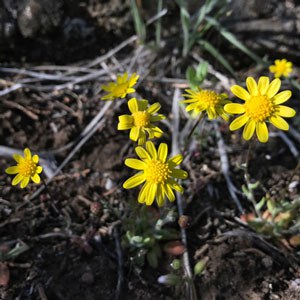
Other common names: Common spring-gold, Gold stars
One of our very first wildflowers of the season, goldfields are a sign that spring has arrived! You’ll find these dime-sized flowers carpeting sagebrush flats. In particularly good wildflower seasons, that's no exaggeration--they truly carpet the ground. Goldfields have a single yellow flower with 8 rays 1/4-1/2” long on a delicate stem up to 6” tall.
Bloom time: Early spring
Spot them at this Land Trust Preserve: Camp Polk Meadow Preserve, Indian Ford Meadow Preserve, Whychus Canyon Preserve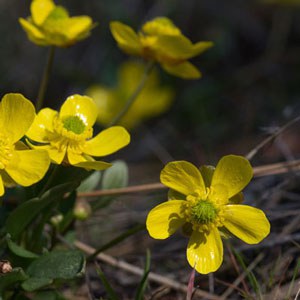
Other common names: N/A
This is another one of the first wildflowers of the season. These yellow flowers can turn white as they age. They are found in sagebrush flats to pine forests. The flowers have 5 petals that are 1/2” long atop a single stem.
Bloom time: Early spring
Spot them at this Land Trust Preserve: Camp Polk Meadow Preserve, Whychus Canyon Preserve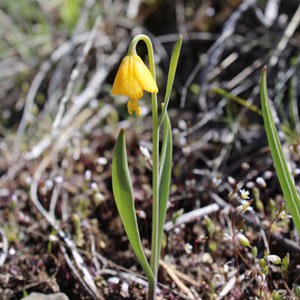
Other common names: Yellow fritillary
A beautiful yellow, pendant-shaped lily that can be found in grasslands to pine forest. Yellow bell flowers are 7/8” long and can be yellow to brownish-orange. Leaves are grasslike.
Bloom time: Early spring
Spot them at this Land Trust Preserve: Whychus Canyon Preserve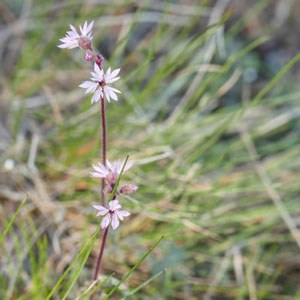
Other common names: Smallflower woodland-star
Reminding us that nature is fragile, this early bloomer has a delicate, white to lavender-pink, irregular flower atop a slender red stem. Prairie stars are found in sagebrush flats to pine forests. Flowers have 5 petals that are 1/4” long atop a 4-12” tall stem.
Bloom time: Early spring
Spot them at this Land Trust Preserve: Indian Ford Meadow Preserve, Whychus Canyon Preserve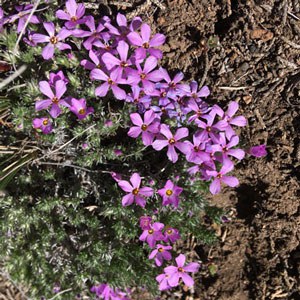
Other common names: N/A
This low-growing flower prefers rocky crevices and exposed locations. These beauties always astound with their pop of color--flowers have 5 pink-purple-white petals. Adapted to extreme environments, cushion-like plants like phlox often have taproots 8-15’ deep!
Bloom time: Early spring
Spot them at this Land Trust Preserve: Whychus Canyon Preserve, Willow Springs Preserve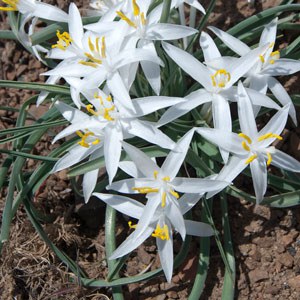
Other common names: Common starlily
Scattered along sagebrush flats and pine forests, sand lilies can often look like bunches of tissue paper dotting your view. It grows in rosette-like bunches with 4-8 white flowers per bunch. Flowers have 6 petals; leaves are 4-8”, flat and linear.
Bloom time: Late spring
Spot them at this Land Trust Preserve: Camp Polk Meadow Preserve, Indian Ford Meadow Preserve, Whychus Canyon Preserve, Willow Springs Preserve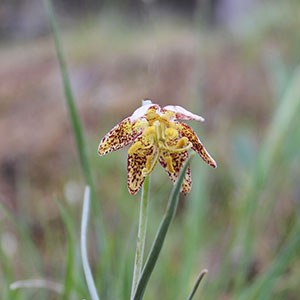
Other common names: Spotted mountain bells
Perhaps one of our most unusual lilies, the spotted fritillary is brown to greenish in color with yellow, red, or white markings. They grow in grasslands or Cascade foothill forests and can be hard to spot because of their subdued color. But just because they are subdued, doesn’t mean they aren’t stunning! The beautiful spotting and delicate petals just beg for a closer look. Flowers hang downward or facing outward and 1-3 blooms can be found per stalk.
Bloom time: late spring-early summer
Spot them at this Land Trust Preserve: Camp Polk Meadow Preserve, Metolius Preserve, Metolius River Preserve, Whychus Canyon Preserve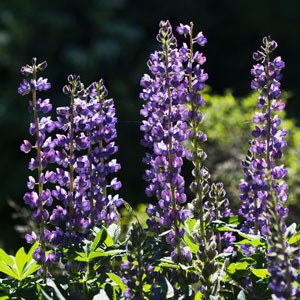
Other common names: Bigleaf lupine
Lupines are quite common in the US, with nearly 600 varieties. The large-leaved lupine has bright green basal leaves with 5-11 leaflets that are 2-3" long. Flowers are blue, lavender, pink, or white with a white patch that often turns reddish with age. This lupine’s name comes from its many leaflets: poly means “many” and phyllus means “leaf.”
Bloom time: Late spring - early summer
Spot them at this Land Trust Preserve: Camp Polk Meadow Preserve, Indian Ford Meadow Preserve, Metolius Preserve, Willow Springs Preserve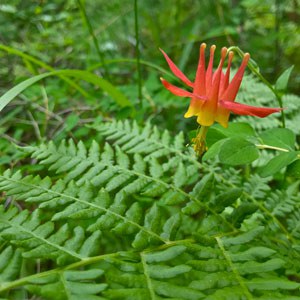
Other common names: Sitka columbine
A showstopper in Central Oregon's forests. As the name implies, red columbine flowers are bright red with some yellow. They can be spotted nodding in the breeze. Plants grow 8 inches to 3 feet tall. Butterflies and hummingbirds love these flowers!
Bloom time: All spring and summer
Spot them at this Land Trust Preserve: Camp Polk Meadow Preserve, Metolius Preserve, Metolius River Preserve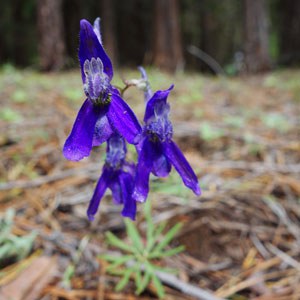
Other common names: Two-lobe larkspur, Upland larkspur
Distinctive purple flowers ¾-1 ¼” across with 5 sepals that look like petals. The uppermost petal has a long hollow spur that holds nectar. Cluster of 3-12 purple wildflowers on a slender stem 6-16” tall. Leaves are on the lowest part of the stem.
Bloom time: Early summer
Spot them at this Land Trust Preserve: Camp Polk Meadow Preserve, Indian Ford Meadow Preserve, Metolius River Preserve, Whychus Canyon Preserve
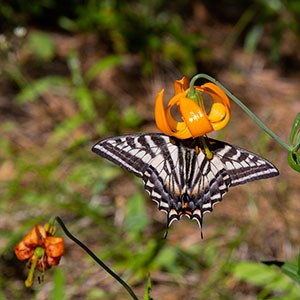
Other common names: Tiger lily, Oregon lily
The curvy bright orange petals of this lily call to you from afar. Columbia lilies have numerous six-petal blooms on a tall stems. Found in the wetter parts of Central Oregon, you can find these along the banks of our local rivers and in nearby mixed-evergreen forest. The fiery orange petals of the Columbia lily curve upward creating a ball of orange with tiny dark spots. Perhaps this is why they are affectionately called tiger lily—can’t you just see the tiger curled and ready to pounce? The edible bulbs of the Columbia lily are prized by Native Americans.
Bloom time: early summer
Spot them at this Land Trust Preserve: Metolius River Preserve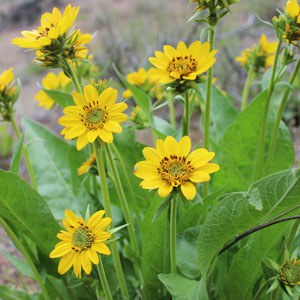
Other common names: N/A
One of our showiest wildflowers, lighting up hillsides with sunny, disk-like faces. Grows in clumps with large widely triangular leaves that have heart-shaped bases. Yellow flowers are 2 1/2 -4” wide on 1-3’ stems.
Bloom time: All summer
Spot them at this Land Trust Preserve: Metolius Preserve, Whychus Canyon Preserve, Willow Springs Preserve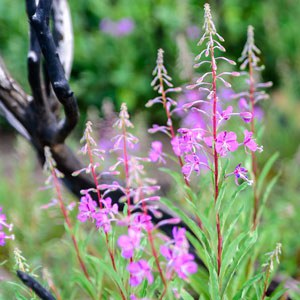
Other common names: N/A
Dense spike of flowers facing outward. Deep pink to magenta petals are ¾-1” wide on 2-5’ stems. Stems are usually reddish with stiff hairs on the upper section. Grows in open and disturbed areas, especially recently burned lands.
Bloom time: All summer
Spot them at this Land Trust Preserve: Whychus Canyon Preserve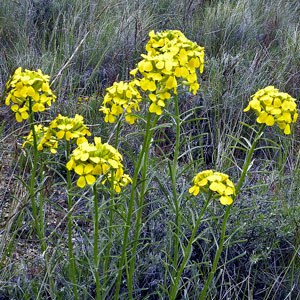
Other common names: Sand dune wallflower, Rough wallflower
Orange to yellow flowers are clustered at the top of 2-4’ stem. Petals are spoon-shaped and narrow where attached. Flowers are often fragrant. Develops seedpods below flowers.
Bloom time: All summer
Spot them at this Land Trust Preserve: Whychus Canyon Preserve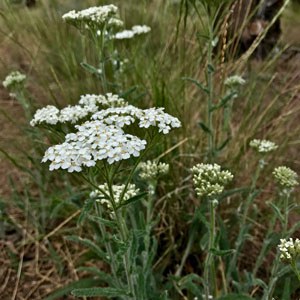
Other common names: N/A
Flat-topped cluster of many flower heads, usually 5 rays each. Flowers can be same color or contrasting white, pink, and purple. Leaves are fernlike with a stem that is 1-2’ tall.
Bloom time: All summer
Spot them at this Land Trust Preserve: Camp Polk Meadow Preserve, Indian Ford Meadow Preserve, Metolius Preserve, Metolius River Preserve, Whychus Canyon Preserve, Willow Springs Preserve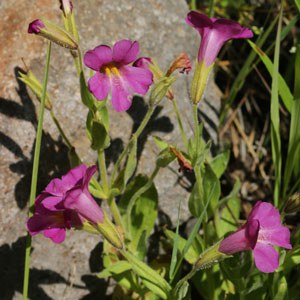
Other common names: Seep-spring monkeyflower, Common western monkeyflower
Flower stalks ¼-3” long, usually with 5 or more yellow flowers near the top. Lower flower lobes have red dots in throat area with smaller upper lobes. Grows in wet places. The flower species is currently being heavily studied to understand evolution and ecology.
Bloom time: All summer
Spot them at this Land Trust Preserve: Whychus Canyon Preserve, Willow Springs Preserve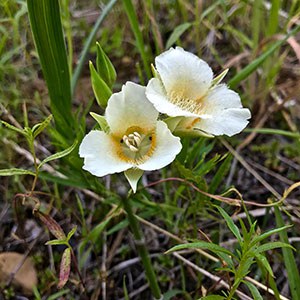
Other common names: Mountain cat’s ear, Cascade mariposa lily
This three-petal stunner is also a favorite in our east Cascade foothill forests. Multiple blooms can be found on an ~8 in tall stem. Flowers are often a creamy white to yellow, but their true beauty is only seen under close examination. Delicate hairs abound on and around the petals of the flower bringing to mind the ear of a cat.
Bloom time: midsummer
Spot them at this Land Trust Preserve: Metolius Preserve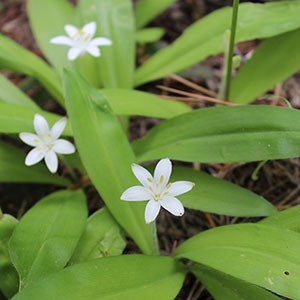
Other common names: Bead lily, Blue bead, Bride’s bonnet
This lily’s common name aptly describes its stately, bright white bloom. Low growing (2-6 in tall) with 2-3 large leaves at its base, queen’s cup lilies are common in forests on the slopes of the east Cascades. You can often find them growing in clumps that form a ground cover on the forest floor. Once its bloom fades, you can still find this lily by its brilliant blue bead-like seed.
Bloom time: midsummer
Spot them at this Land Trust Preserve: Metolius Preserve, Metolius River Preserve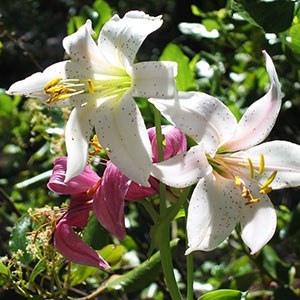
Other common names: Washington lily
This may be the true queen of the lilies! Large, opulent flowers on 2-8 ft tall stalks bring to mind traditional lilies that are sold in flower shops. Each plant boasts several white to pinkish flowers with as many as 25 blooms per plant. Leaves are in regular whorls moving up the stem. Can be found in east Cascade foothill forests lighting up an otherwise brown and green landscape.
Bloom time: midsummer
Spot them at this Land Trust Preserve: Metolius Preserve, Metolius River Preserve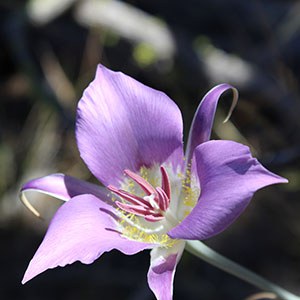
Other common names: Green-banded lily
This is one of the showy lilies that bucks the trend! Instead of retreating to the cooler forested foothills, the mariposa lily loves the sagebrush desert and blooms at a time of year when many other flowers have finished. Large purple to pink flowers on 8-23 in tall stems. Like their cousin, the subalpine mariposa lily, these lilies are best appreciated up close where you can see their lovely yellow and pink-banded throat.
Bloom time: midsummer
Spot them at this Land Trust Preserve: Whychus Canyon Preserve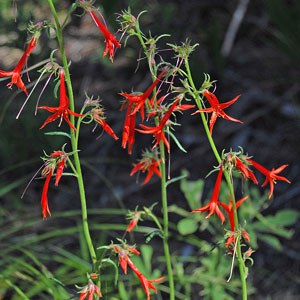
Other common names: Skyrocket
Trumpet-shaped, bright red flowers on stems up to 3’ tall. Flower color may vary from scarlet speckled with white, to pale pink speckled with red. Grows in dry soil in woodland openings and meadows.
Bloom time: Midsummer
Spot them at this Land Trust Preserve: Metolius Preserve, Metolius River Preserve, Whychus Canyon Preserve
Learn more:
- Join the Land Trust for a guided walk or hike and see what's blooming!
- Learn more about the wildflowers of Whychus Canyon Preserve.
- Are you an experienced botanist? See our full Whychus Canyon wildflower list.


